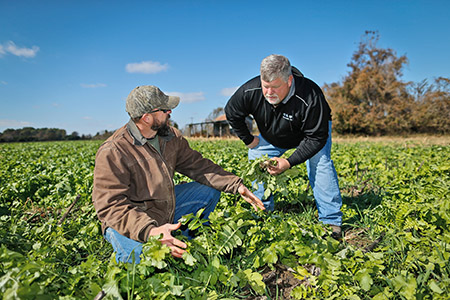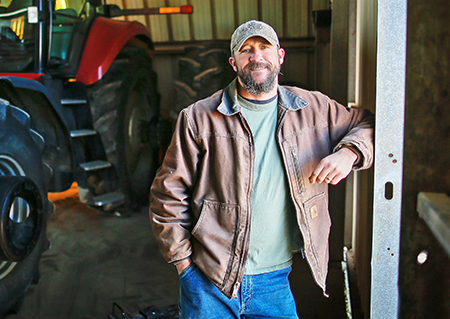This yearlong endeavor looks at how four farmers are evaluating technology and agronomic information that can boost the productivity of their operations.

Heath Whitmore's corn/soybean operation often resembles a research farm. This St. Charles, Ark., farmer tries new things every year to push yields. "Seeing how well a new practice or product works on our farm is where we get our own yield verification trials," Whitmore says.
"In fact, any time BASF innovation specialist Brad Koen needs to field test an innovation, he noses his pickup toward Whitmore Farms. "Not only is Heath always ready to try something new, he's willing to take the time and trouble at harvest to weigh out test strips to quantify the yield difference," says Koen, based in DeWitt. "We usually do two to three trials a year on his farm."
Whitmore and his father, Kirk, are partners in their family farm, which turned 100 years old in 2014. The family's 1,200-acre grain operation includes 400 to 500 acres of corn, with the balance in soybeans. "We are a true family farm," Whitmore says. "We're small and we concentrate on making the most quantity on each acre. With our high-yielding beans and corn in the past three years, we essentially get an extra 20 bushels of beans [per acre] and an extra 30 bushels of corn that we don't have to pay for."
Last season was a great one for Whitmore. He had record rainfall; plenty of timely rains took a lot of pressure off his irrigation management - his farm is 100% irrigated, all row watered. His 2014 soybean crop averaged 75 bushels per acre, and the corn crop made 230 bushels per acre.
As pleased as he is with his yields, Whitmore constantly tries to find ways to make his operation more efficient. He tested several new practices in 2014 that he believes will help bump up his yields even more in 2015.
For example, he tried using two fungicide applications on soybeans. "Since we're trying to grow high-yield beans, we apply a fungicide on all of our crop," he says. "The best time to apply fungicides to prevent disease is R3, when pods are first forming on the plant. We sometimes get late-season diseases when that fungicide plays out. For several years, we have overlapped residual herbicides to control weeds, so we decided to overlap fungicides," he adds.
As a result, the Whitmores applied a second fungicide at the same rate at R5, about two to three weeks after the first application. "On one field of double-shot fungicide last year, we saw anywhere from a 4- to 6-bushel difference over our one-shot fungicide soybeans," he says.
Koen says a single fungicide application, including the aerial application cost, averages $20 per acre. At $10 beans, a 4- to 6-bushel yield increase from a sequential fungicide application means an extra $40 to $60 per acre. "Subtract the $20 cost, and you have a $20 to $40 return on investment," he notes.
Another new practice Whitmore tried in 2014 and plans to use on a larger scale this year is aerially broadcasting 100 pounds per acre of prilled (small pellets) urea on soybeans. Koen explains, "A soybean plant produces enough nitrogen to make 70-bushel soybeans. You will make the plant lazy if you put nitrogen on soybeans at the wrong time; it will stop producing nitrogen. We want the plant to make as much nitrogen as it can, and then apply nitrogen at R3, when it goes into full reproductive growth."
"Where we apply sequential applications of Priaxor fungicide and 100 pounds of urea, we consistently pick up 12 to 15 bushels," Koen says. "Heath cut 95 bushels per acre where he applied two fungicide shots and 45 units of nitrogen."

Whitmore is already trying several new things for 2015. For example, he planted a cover crop on three fields, totaling 50 acres. He planted a pre-blend mix of five different seeds: tillage radish, clover, cereal rye, oats and triticale. He is trying the cover crop on a farm that has been in corn for three continuous years. Whenever he previously rotated that farm to soybeans, deer damaged the crop.
"Some parts of that farm has not been disked in eight or nine years," he says. "One of the cover crop seeds is a tillage radish that grows thick and deep and helps fracture the hardpan. Additionally, the seed mix has clover that will help get more ground nitrogen to push corn yields. We'll burndown the cover crop right before it starts blooming; the nitrogen supposedly remains as native soil nitrogen. Cover crops fit in perfect with our minimum-till/no-till system."
Something else new for Whitmore in 2015 is a Great Plains vertical tillage rig that has no pitch on the blade. "If we have to combine when it's a little wet, and leave ruts or cleat marks from harvest equipment, this vertical rig enables us to get into our fields sooner," Whitmore says. "It's very low impact, very low-compaction tillage that chops up residue."
Trying innovative things. Every year. That's how Whitmore pushes high yields.